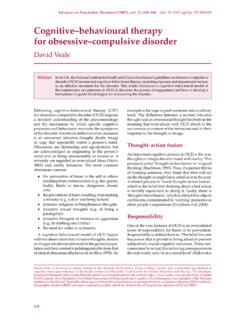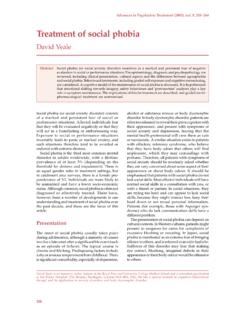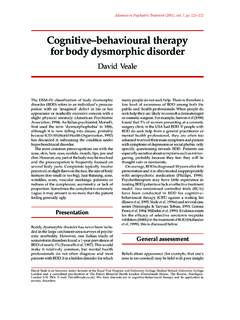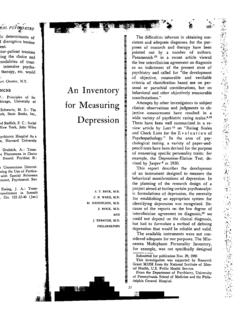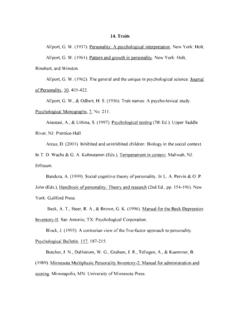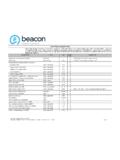Transcription of The Psychopathology of Vomit Phobia - Professor …
1 Behavioural and Cognitive Psychotherapy, 2006, 34, 139 150 Printed in the United Kingdom Psychopathology of Vomit PhobiaDavid Veale and Christina LambrouKing s College London, Institute of Psychiatry, survey of individuals was conducted on self-diagnosed Vomit phobics comparedto panic disorder and non-clinical controls. Vomit phobics were overwhelmingly female andhad had symptoms for over 25 years. They were significantly more likely to fear themselvesvomiting (in public and private situations) than fear others vomiting. The Vomit phobicsinterpreted sensations of nausea as impending Vomit and had a wide range of safety seekingand avoidance behaviours that were maintaining their fear.
2 Although the Vomit phobics reportedfeeling nauseous more often, there was no difference in their frequency of vomiting comparedto the control group. The clinical implications of the study for therapy are :Specific Phobia , Vomit , descriptive specific Phobia of vomiting (also known as emetophobia) is a greatly under-researched of Vomit Phobia have been described as presenting as anorexia nervosa (Manassis andKalman, 1990), but generally little is known about the phenomenology or treatment. Comparedto other specific phobias , clinicians generally regard it as challenging to treat because of highdrop out or a poor response to treatment. One survey of Vomit phobics has been conducted byLipsitz.
3 , Fyer, Paterniti and Klein (2001), who reported the mean age of onset was yearsold and 89% of their sample was are no specific models for Vomit Phobia or RCTs for its treatment. Marks (1987)suggested that some types of Vomit Phobia were a type of social Phobia because of the concernover possible humiliation. Pollard, Tait, Meldrum, Dubinski and Gall (1996) proposed that theavoidance behaviour in Vomit Phobia was part of agoraphobia without panic. There are onlyfour case reports in the literature describing treatment by behaviour therapy (McFadyen andWyness, 1983; Herman, Rozensky and Mineka, 1993; Philips, 1985; Lesage and Lamontagne,2003); one of systemic behaviour therapy (O Connor, 1983); one of psychotherapy (Manassisand Kalman, 1990); two of hypnotherapy (Ritow, 1979; McKenzie, 1994) and one witha combination of the above (Wijesinghe, 1974).
4 Many of these studies were published10 25 years ago and since then there have been significant developments in our understandingof maintaining factors in anxiety , specifically the role of attentional biases, catastrophic beliefsand safety seeking aim of this study was therefore exploratory: to learn more of the beliefs; safety seekingand avoidance behaviours in Vomit Phobia ; the similarities and differences to panic and otherReprint requests to David Veale, The Centre for anxiety Disorders and Trauma, South London and Maudsley Trust,99 Denmark Hill, London SE5 8AZ, UK. E-mail: 2006 British Association for Behavioural and Cognitive Psychotherapies140D.
5 Veale and C. Lambrouanxiety disorders, and develop a better understanding of the factors that maintain the , this should lead to the development of innovative treatment strategies that are inkeeping with developments in other anxiety hundred and nine participants were recruited for the study. The sample consisted of threegroups: Vomit phobics (n=100); panic disorder (n=28) and a non-clinical control group(n=81). Participants were recruited through various sources. Vomit phobics were recruitedthrough the newsletters of the support group Gut Reaction and the National Phobics Society inthe UK. The Vomit phobic patients were self-diagnosed as it was not possible to interview themto confirm the diagnosis when they were sent a questionnaire.
6 Individuals with panic disorder(as diagnosed by DSM IV) were recruited from a clinical setting. Non-clinical controls wereeither relatives or friends of the two patient groups. To recruit non-clinical controls, bothpatient groups were instructed, in the covering letter, to pass the Vomit Questionnaire (forhealthy controls) to a relative or friend (male or female) who did not suffer from Vomit phobiaor another psychiatric clinical and control groups were asked to complete a questionnaire about their fearof vomiting and experience of nausea. Three versions of the Vomiting Questionnaire weredesigned for each of the participant groups:(a) Vomit Questionnaire for healthy controls: this was the shortest version of the questionnaire(total of 24 items) and consisted of demographics; general questions regarding pastexperiences of vomiting; the probability and awfulness of consequences that may occurafter vomiting.
7 (b) Vomit Questionnaire for Panic Disorder: this version consisted of 50 items and included theitems for healthy controls and questions regarding: (i) frequency of sensations of nauseaand perceived causes of nausea; (ii) beck anxiety inventory ( beck , Epstein, Brown andSteer, 1988). The instructions were modified to ask participants to rate the degree eachsymptom was experienced during episodes of feeling sick rather than when they feltanxious; (iii) the Panic Cognitions Questionnaire (Salkovskis, Clark, Hackmann, Wellsand Gelder, 1999). The questionnaire was modified so that instead of rating the thoughtsexperienced when they were most anxious, they were asked about the frequency andstrength of thoughts going through their mind when they felt sick; (iv) a modified versionof the Safety Behaviours Questionnaire (Salkovskis et al.)
8 , 1999). The participants wereasked the frequency of what they did when they felt sick. This differs from the originalversion, which asks what respondents do when they are most anxious or panicky. Sevensafety seeking behaviours relevant to vomiting in the original questionnaire were alsoadded.(c) Vomit Questionnaire for Vomit Phobics: this was the most detailed version (total of 63items) and included items for both of the above as well as avoidance behaviour becauseof the Vomit Phobia ; interference and past treatment of Vomit were analysed in SPSS using One Way Analysis of Variance for continuous data,which was normally distributed and Chi-square for the categorical data.
9 Because of the largenumber of significance tests, we set the level of significance atp<. Psychopathology of Vomit phobia141 Table 1 Demographics of Vomit phobics, panic disorder and non-clinical controlsVomit phobiaPanic disorderNon-clinical controlsMean (SD)Mean (SD)Mean (SD)N=100N=28N= ( ) ( ) ( )F(2, 188)= ,p=<.053 Genderm=3%m=39%m=52%Chi-squared= ,f=97%f=61%f=48%df=2,p<. 0001 Table 2 Fear of vomiting alone or in publicVomit phobicsPanic disorderControlsN=98N=28N=77I have no fear of myself vomiting0% (0) (12) (61)I fear myself vomiting in public or socialsituations (3) (8) (7)My main fear is of myself vomiting in publicbut I have some fear of vomiting (16) (2) (3)I fear myself vomiting whether it is inpublic/social situations or (76) (5) (1)My main fear is vomiting alone but I also havesome fear of vomiting in public or (1)0% (0) (2)I fear myself vomiting alone (2) (1)0% (0)ResultsThe demographics of the three groups are shown in Table 1.
10 The three groups did not differsignificantly in age. There was a significant difference on gender between the groups, accountedfor by far more women in the Vomit phobic group. Unfortunately, at the time of collecting thedata we were not aware of the previous survey by Lipsitz et al. (2001), and did not match ourcontrol group by mean age of onset in the Vomit phobic group was years old ( ) and it wasdescribed as first becoming a problem at years old ( ). The mean duration of vomitphobia was years ( ; range 4 years to 65 years).Fear of vomiting alone or in public situationsParticipants were asked which statement best described their beliefs about vomiting alone or inpublic situations.


